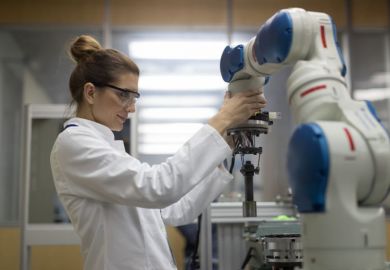The government’s ambitious aim is to raise the overall research and development intensity of the UK economy to 2.4 per cent of GDP, compared to its current level of 1.7 per cent. And if we want R&D spending as a percentage of GDP to rise by about 50 per cent to help us to meet this target, we will also need 50 per cent or so more researchers.
I welcome the budget announcement this week of £100 million to attract international talent to the UK, but if we are to increase the number of active researchers in the UK by the order of approximately 50 per cent, it is impossible to imagine that this could – or should – be achieved entirely through importing all of that talent from abroad. We are going to need to grow more of our own.
UKRI is putting its money where its mouth is. At “our end” of the talent pipeline, UKRI spends about £600 million every year on PhDs, fellowships and other skills interventions. Additional money from the National Productivity Investment Fund has enabled us to kick-start the process of improving the pipeline.
We have committed to creating more than 1,000 new PhD places and the extra funding has allowed UKRI to launch the new Future Leaders Fellowship, which will support the growth of a cadre of more than 500 world-leading researchers and innovators. Yesterday’s budget announcement of £100 million for international fellowships is a further sign of the government’s commitment to continuing to recruit top researchers to the UK.
We can and we will do more to increase the number of research leaders and PhD graduates that drive our knowledge economy. We also need to continue to ensure that we attract – and are free to attract – outstanding talent from outside of the UK. However, we are also at the very end of and dependent on a talent pipeline that runs through the UK’s education system.
The pipeline concept was, I think, first mapped out and analysed in a seminal report by the Welsh physicist, the late Gareth Roberts. The big picture is clear and unavoidable. Achieving 2.4 per cent will require major improvements at all stages of the skills pipeline. The biggest challenge is at the beginning of the pipeline – in schools.
We should note that some real progress has been made in recent years. Maths is now the most popular A level, taken by 26.9 per cent of students taking academic qualifications. From 2010 to 2018, we have seen an increase of 25.9 per cent more women entering STEM A levels in England and more students are also taking triple science.
But we also need to remind ourselves about how far we have to go. A recent paper by the Education Policy Institute outlines that only 50 per cent of physics teachers and 46 per cent of maths teachers in the UK have a relevant degree and that exit rates are also alarmingly high. In deprived schools outside of London, the figure is as low as 17 per cent for physics teachers.
There are all sorts of ways of attracting talent into teaching, but there is a critical obstacle: pay. The fact is that STEM graduates are very employable outside of teaching and can attract significantly higher salaries.
Against this background, it appears that a large number of schools are – whether for financial or cultural reasons – deploying an unqualified, or at any rate underqualified, teacher in STEM classrooms, or simply tolerating a vacancy. It is difficult to envisage a true step-change in the quality and quantity of UK STEM teaching that does not grasp this nettle.
The government has not been asleep on this job and has taken the following steps: it is planning to make one-off payments of £5,000 (or £7,500 in some areas) to maths teachers who remain in teaching three and five years after qualifying. The Department for Education will be offering reimbursements of the student loan repayments that biology, chemistry, computer science, language and physics teachers have made, targeted in 25 local authorities. Yesterday’s budget announced a further £10 million for a regional trial to test how to improve retention of early career maths and physics teachers.
These initiatives are greatly welcomed. But we need to ask whether they match up against the scale of the challenges that we face – and the opportunity that we have – as a nation. Do we not need to go significantly further?
Recent work by the Gatsby Foundation examined the potential effects of even a 5 per cent salary supplement, paid directly to schools, for qualified science and maths teachers. The benefits of such an intervention would be material and the costs would be surprisingly manageable.
So why not bite the bullet and find an effective mechanism to ensure that qualified STEM teachers are paid more, to reflect the straightforward reality that they are scarcer and in more demand than teachers in other subjects?
The government wants the UK to be what it should be: a major scientific nation. In order to achieve this, a reasonable starting point is that all children in Britain’s state schools should have the opportunity to be taught STEM subjects by qualified teachers with the aim that more of them would then go on to study STEM, which would benefit themselves, society and the economy – and in the case of at least some of them, British science.
Sir John Kingman is chair of UK Research and Innovation.
Register to continue
Why register?
- Registration is free and only takes a moment
- Once registered, you can read 3 articles a month
- Sign up for our newsletter
Subscribe
Or subscribe for unlimited access to:
- Unlimited access to news, views, insights & reviews
- Digital editions
- Digital access to THE’s university and college rankings analysis
Already registered or a current subscriber?



